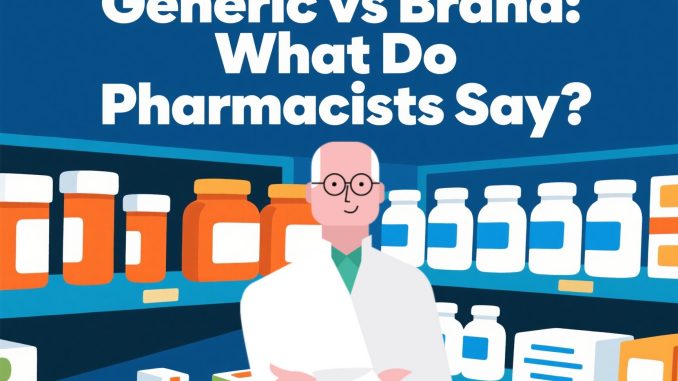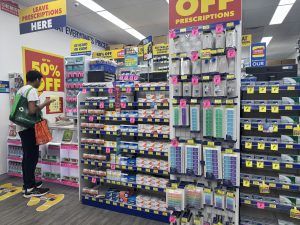

“The cheaper one, please.”
He glanced at the options the pharmacist presented and responded without hesitation.
If you’ve ever visited a Chemist Warehouse in Australia, this phrase probably sounds familiar. For many patients, especially those with chronic illnesses or limited budgets, price is a major factor. But in the pursuit of a better deal, do they truly understand the medications they are putting into their bodies?
To get a clearer picture of what’s happening behind the counter, I spoke with Ivy, a student pharmacist working at Chemist Warehouse.
Student pharmacist Ivy from Chemist Warehouse shares her journey in pharmacy during an interview with Yuhe Zhang on May 22, 2025, at the Queen Mary Building.
The Role of Cost in Medication Decisions
“Patients definitely care most about whether the medicine works… After that, it’s usually the cost. So if a patient asks for something more affordable, we’ll offer them a generic option,” Ivy said.She explained that generics cost less since they avoid the research and marketing expenses of brand-name drugs, with only minimal differences between them.
It sounds like a win-win, same treatment, lower cost. And in many cases, it is. Australia’s Pharmaceutical Benefits Scheme (PBS) supports the widespread use of generics to reduce national healthcare costs and improve access. Most common prescription medications fall under the PBS threshold of $31.60 for general patients.

Subtle Differences Between Generics and Brand-Name Medicines
But in reality, the difference isn’t only about cost. “From what I’ve seen, most patients just see it as a price difference,” Ivy said. Yet generic and brand-name drugs can differ in inactive ingredients, bioavailability, and how individual bodies respond to them, even if those differences are subtle.
That subtlety can matter, especially with sensitive medications like blood thinners. Ivy noted that some prescriptions are marked “brand substitution not permitted,” meaning the pharmacy must dispense the original drug. Even if the doctor doesn’t specify this, Ivy said she recommends that patients continue using the same brand if they’ve been taking it regularly. “Even small changes in blood levels can have serious consequences,” she emphasized.
When Safety Isn’t the Problem, But Understanding Is
The issue isn’t that generics are unsafe. In Australia, all medicines must be approved by the Therapeutic Goods Administration (TGA), which ensures their effectiveness and manages risks within safe limits. Some patients even find generics more effective than brand-name drugs, although this usually comes down to individual body chemistry rather than any measurable difference.
The real problem is that many patients simply don’t know which version they’re taking or that there is any difference at all. Although the Generic Prescription Medicines fact sheet on the TGA’s website provides clear explanations, much of the information is presented in technical language that can be difficult for the average person to understand.
As a result, while the public technically “has access to information,” understanding it is a different matter. Some patients rely on quick online searches or social media, where medical content is often fragmented, inaccurate, or even misleading. Ivy mentioned she frequently meets patients who are overly anxious or misinformed because of what they’ve read online.
The Diminishing Role of Pharmacists
This information gap isn’t entirely the patient’s fault. “If patients don’t ask, we usually don’t explain,” Ivy admitted. In fast-paced retail environments like Chemist Warehouse, pharmacists rarely start detailed conversations about the differences between generic and brand-name drugs, and most customers do not know what questions to ask. As a result, generic versions often become the default option.
Pharmacists, who could be a trusted source of information, are too often reduced to retail clerks in a transactional system. The counter becomes more like a checkout lane than a place for genuine dialogue and informed choices. And that raises an important question about how Australians relate to healthcare: By reducing medication to a price tag, are we also reducing the role of pharmacists in our health system?
System Pressures and Hidden Effects
While the PBS provides many benefits, it may unintentionally reinforce this behavior. Because brand-name medications sometimes require out-of-pocket payments that are not covered by the PBS, patients may choose the cheaper generic without fully understanding the advantages and disadvantages. Affordability matters, but it should not come at the cost of clarity or confidence in treatment.
Medicine is not one-size-fits-all
The solution is not to discourage the use of generic medications, which continue to be fundamental to affordable healthcare. Rather, Australia requires a more comprehensive strategy for patient education that extends beyond technical fact sheets and regulatory websites.
Although the TGA has strict standards for drug approval, people’s bodies, conditions, and lifestyles vary, so treatment decisions must be tailored. If the public had better access to clear and understandable information, they could make more informed choices and reduce the burden on pharmacists, who constantly balance efficacy and cost to ensure patients receive appropriate treatment without unnecessary financial strain.
More Than Just Dispensing Medicines
The changes needed go beyond just educating patients. We also need to rethink the role pharmacists play in Australia’s healthcare system. Many pharmacists find themselves caught between business pressures and professional duties, especially in big retail chains where quick service and sales targets often come before patient consultations. This creates real challenges. Pharmacists must juggle making sure treatments work while keeping costs manageable, so patients get the care they need without extra financial burden.
From my interviews, it’s clear many pharmacists want more time and opportunity to have meaningful conversations with patients. These talks can help people better understand their treatment and improve health outcomes.
Ultimately, the conversation around generics versus brand-name medications should be just that: a conversation. It should not be only about price tags and wallets, but a dialogue between patient and pharmacist. Medicines are more than commodities; they represent trust, care, and health. Encouraging such dialogue not only helps individuals find the treatment that is right for them but also restores the vital role of pharmacists in Australia’s healthcare system.



Be the first to comment